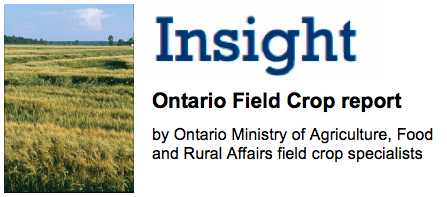Canola/Edible Beans: Brian Hall
Canola: Early planted canola is in mid to full pod stage. The majority of April planted canola is in the mid to late flowering stage. Cabbage seedpod weevil populations have declined from their peak, but control is warranted at early flower if 2-4 weevils per sweep are found. Scout canola during flowering to early pod stage for tarnished plant bug and diamond back moth. Hot, dry weather favours these insect pests. Threshold for tarnished plant bugs is 1-2 bugs per sweep. Peak populations of 1st generation swede midge occurred week of May 18th, and have since decreased sharply, so risk of damage to canola now is minimal.
Edible Beans: The majority of edible bean crop is in cotyledon to 2nd trifoliate stage. Plant populations are good except for where seed was not planted into moisture or where soil crusting was an issue. Potato leafhopper adults can be found in low numbers in most fields. Seed treatment with thiamethoxam (i.e. Cruiser) will provide control of moderate leafhopper populations for 4-6 weeks following planting. Watch for numbers to build quickly as leafhoppers move in from alfalfa fields being harvested. Under hot weather conditions, nymphs hatch in about 10 days. The leafhopper control threshold is 0.25 insects/plant at the unifoliate stage, 0.5 insect per trifoliate at the second trifoliate and 1 insect per trifoliate at the fourth trifoliate.
Cereals: Peter Johnson/Scott Banks
High temperatures and dry soils are rapidly ending the grain fill period of winter cereals in the southernmost areas. Winter barley harvest began Tuesday June 19th. It is now too late for any management opportunities in winter cereals, including spraying for armyworm. Do not wait for crops to reach dry moistures before harvesting (14%). Test weights drop 1 pound/bushel for each rain event that occurs after maturity (30%). Early harvest results in higher yields and better quality grain, which offset drying costs. Harvest as soon as combines can thresh the grain.
Spring cereals continue their rapid pace of development. High aphid and cereal leaf beetle numbers are reported in some fields. Scout and control as warranted. Barley yellow dwarf levels are high in some areas. Leaf diseases remain almost non existent in most fields, with spot blotch at significant levels in a few barley fields.
Corn: Greg Stewart
Warm temperatures continue to push crop development. The majority of the crop is in very good condition. The exceptions would be some of the earliest corn that is less uniform due to cold temperature stresses and some of the later planted corn that went 3 weeks without a rain after planting and has uneven emergence or soil compaction issues. Rapid growth symptom (pale leaves emerging from the whorl) has virtually disappeared. Some sulphur deficiency in corn and seed corn has been confirmed on sandy soils and eroded knolls. Potash deficiency on lower testing soils is also showing up. Western Bean Cutworm (WBC) traps have identified a few WBC moths in the southwestern part of the province. Stay up to date with WBC issues and trapping results at www.cornpest.ca.
Forages & Pastures: Jack Kyle / Joel Bagg
Forages: Humid, wet weather has made dry hay making more challenging in some areas. Lots of hay preservative and plastic wrap is being used. Low soil fertility reduces forage yield and persistence. Forages remove about 14 lbs P2O5 and 54 lbs of K2O per tonne of mixed hay, equivalent to about 2.0¢ per lb. Without replacement with manure or commercial fertilizer, soil tests drop quickly. If a soil test is below 120 ppm of K, you can expect a yield response from top-dressing potassium http://fieldcropnews.com/?p=3760 . Nitrogen applied to grassy fields with adequate soil moisture will increase yields. A rule of thumb is 60 lbs/ac actual N per tonne of yield expected in the next cut. Apply fertilizer and liquid manure immediately after harvest to minimize wheel traffic damage.
Pasture: Significant armyworm damage has been reported in a number of pastures and hay fields, particularly along the north shore of Lake Erie through to the Huron and Bruce counties. Many pastures are showing the effect of high temperatures and low soil moisture. Taking steps now to acquire extra pasture or alternative feed sources will pay significant dividends over the summer. Applying 40 kg/ha of nitrogen will stimulate grass growth that will provide extra summer pasture. Consider clipping mature forages or flowering weeds to stimulate new forage growth and stop the weeds from setting seed. A rotational system that gives pastures 30 to 45 days or more of rest between grazings will give the most productivity.
Soybeans: Horst Bohner
Fields are now at the third trifoliate, with early stands beginning to flower (R1 stage). Thin plant stands continue to be an issue. Soil moisture is adequate for nodulation and N fixation to begin in most fields. In very dry areas N fixation is slow, resulting in a pale looking crop. If beans show yellowing between the leaf veins, but the veins remain dark green they are suffering from Manganese (Mn) deficiency. Ontario research has shown that for fields with a history of Mn deficiency, a foliar application of Mn can provide an additional 4 bu/ac. Yield increases are only evident if a true Mn deficiency is present. Applying Mn to either conventional or glyphosate tolerant varieties that show no symptoms will not provide any yield benefit. Ideally, Mn should not be mixed with glyphosate because it reduces the effectiveness of the glyphosate and reduces the efficacy of the Mn. At least 10 days should separate the application of Mn and glyphosate.




